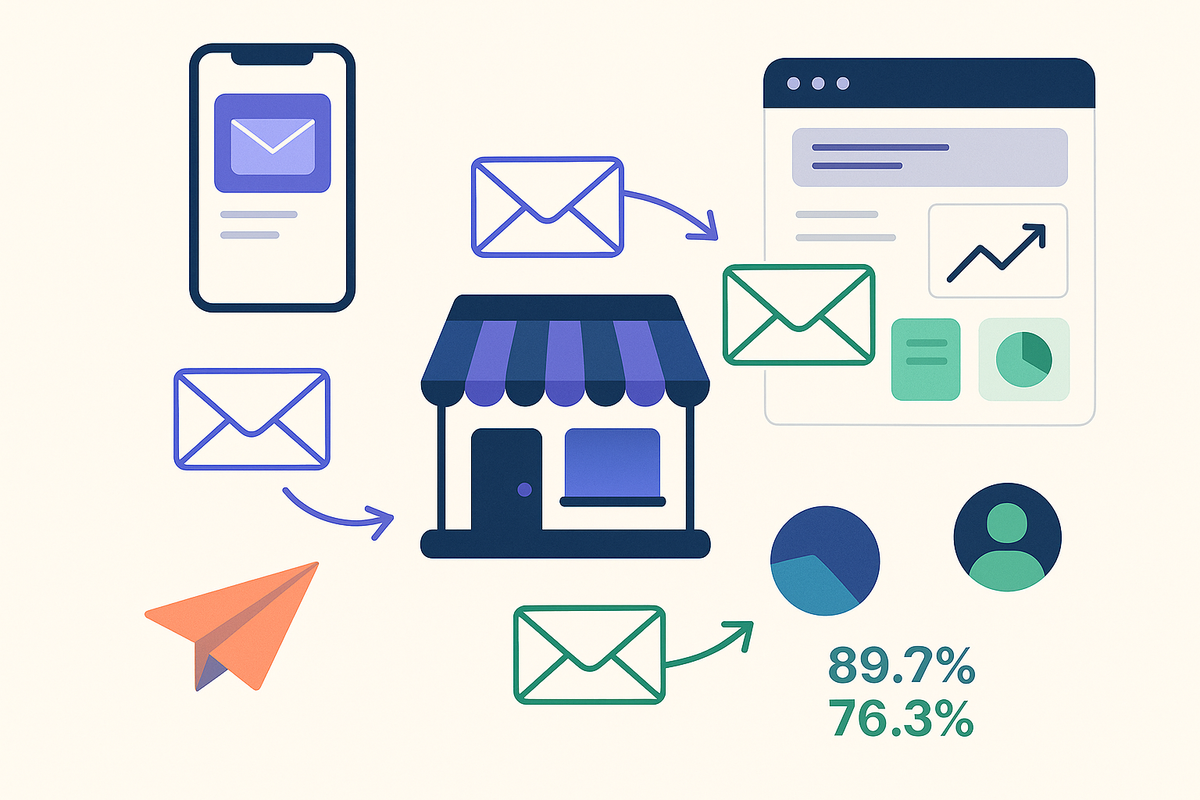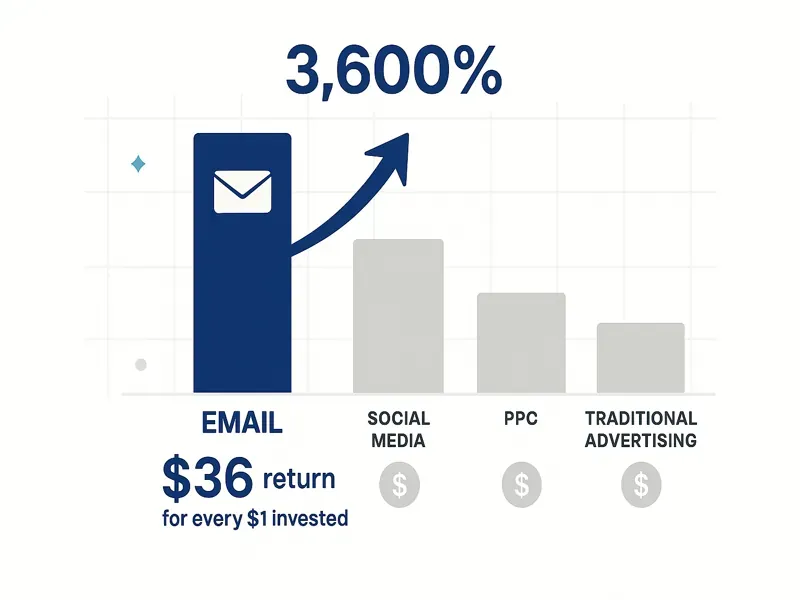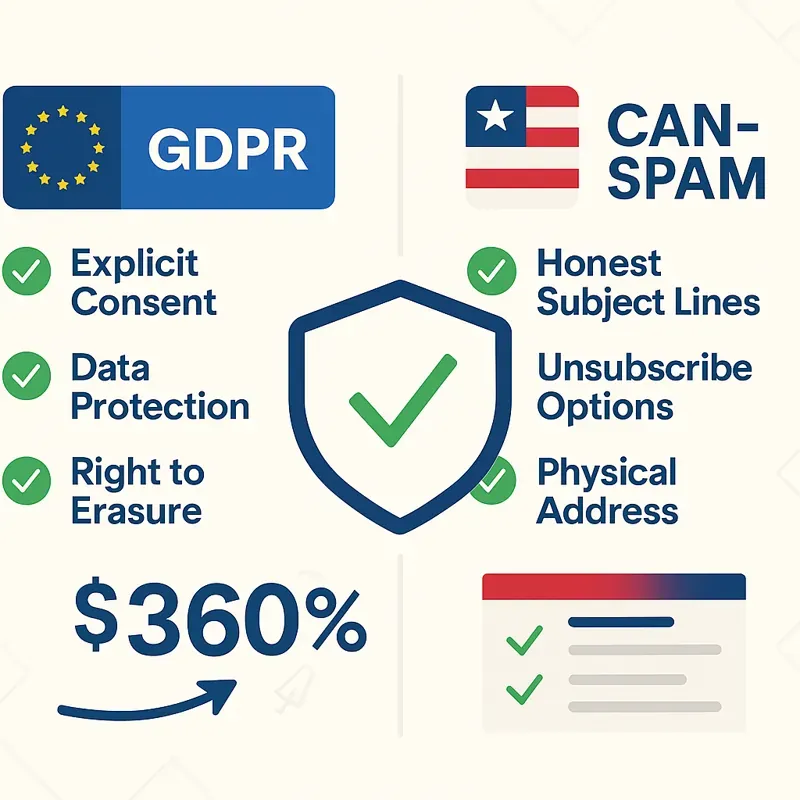Email Marketing for Small Business: Real Stories & Practical Tips
Master the art of email marketing with proven strategies that deliver a 3,600% ROI. Complete guide with real case studies from small businesses.

I'll be honest—when I first heard about email marketing generating $36 for every $1 spent, I thought it was too good to be true. But after diving deep into the data and talking to dozens of small business owners, I can confirm that email marketing isn't just alive—it's absolutely crushing it for businesses that do it right.
Let me share what I've learned about making email marketing work for small businesses, including some surprising case studies that'll change how you think about your marketing budget.
Why Email Marketing Still Dominates in 2025
Despite predictions of email's death, 4.6 billion people will use email in 2025—that's more than half the global population. While your competitors chase shiny new platforms, email quietly delivers the highest ROI of any marketing channel.
Here's what caught my attention: 81% of small businesses use email for customer acquisition, and 64% actively use it to reach customers. But here's the kicker—only 13% measure their ROI properly.
💰 Revenue Impact: Email marketing generates an average ROI of 3,600%, with retail and ecommerce seeing returns up to 4,500% (Email Monday)

Real Small Business Success Stories That'll Inspire You
Case Study 1: The 45-Contact Miracle
When Main Street ROI worked with a San Francisco chiropractor, they had just 45 prospective patients on their list. Most people would've said, "Why bother?"
Instead, they created a simple 3-email sequence promoting a 50% off "Summer Tune-Up" service. The results? Over $1,000 in revenue from those 45 contacts. That's roughly $22 per email address—not bad for a "tiny" list.
The emails were 100% text with no fancy design. The strategy was simple: announce the promotion, send a reminder a week later, then a final reminder before the deadline.
Case Study 2: The Fashion Brand Facebook Algorithm Crisis
An e-commerce fashion brand was generating solid sales through their private Facebook community. Then Facebook's algorithm changes hit, and their conversions plummeted overnight.
According to Selzy's case study, they pivoted to email marketing and transformed generic welcome messages into personalized style narratives with brand-centric animations. They timed emails for when their audience was most engaged.
Result: £25,000 (about $31,000) in revenue over three months from email alone.
Case Study 3: The 25% Pre-Sale Success
MailerLite documented an e-commerce store that used email marketing to presell 25% of a new product before release day. They segmented their list based on past purchase behavior and sent targeted preview emails to their most engaged customers.
This wasn't just about revenue—it helped them gauge demand and adjust inventory accordingly.
The Email Marketing Landscape for Small Businesses
| Key Metric | Industry Average | Small Business Reality |
|---|---|---|
| Open Rate | 32.55% | Varies by industry (14-37%) |
| Click Rate | 2.6% | 1.5-3.2% depending on segmentation |
| ROI | $36 per $1 spent | Often higher with proper targeting |
| Unsubscribe Rate | 0.1% | Under 0.5% with quality content |
Source: Constant Contact and Sixth City Marketing
Building Your Email Foundation the Right Way
Start With Compliance (It's Easier Than You Think)
Before we dive into strategy, let's tackle the compliance elephant in the room. The CAN-SPAM Act and GDPR aren't as scary as they sound.
CAN-SPAM Basics:
- Use honest subject lines
- Include your physical address
- Provide clear unsubscribe options
- Honor opt-out requests within 10 days
GDPR Essentials:
- Get explicit consent before emailing EU residents
- Keep records of consent
- Provide easy data deletion options

The Federal Trade Commission can fine businesses up to $50,000 per violation, while GDPR fines can reach €20 million or 4% of global turnover. But don't panic—compliance is straightforward with the right tools.
Ready to implement this? Try Groupmail's drag-and-drop builder free—unlimited sending included, with built-in compliance features.
The List Building Strategy That Actually Works
Forget buying email lists. 89% of marketers use email as their primary lead generation channel, but they're building lists organically.
What Works:
- Lead magnets (free guides, templates, checklists)
- Website opt-in forms with clear value propositions
- Social media campaigns driving to landing pages
- Content upgrades on blog posts
What Doesn't:
- Purchased lists (poor performance, compliance issues)
- Auto-adding customers without consent
- Hidden or confusing opt-in processes
The Psychology Behind High-Converting Emails
Subject Line Science
Campaign Monitor research shows 28-50 characters is the sweet spot for subject lines, but there's more to it than length.
High-Performing Subject Line Patterns:
- Personalized lines increase opens by 18.30%
- Urgency without being pushy
- Benefit-focused rather than feature-focused
- Questions that create curiosity
💡 Pro Tip: 65% of marketers personalize subject lines, but only the best test multiple versions to find what resonates with their specific audience.
Mobile-First Design Matters More Than Ever
With 60% of emails opened on mobile devices, your emails must look great on smartphones. This means:
- Single column layouts
- Large, tappable buttons
- Concise subject lines (under 40 characters)
- Preheader text that adds context
Advanced Strategies for Small Business Success
Segmentation: The Revenue Multiplier
51% of marketers believe segmentation is the most effective email strategy, and for good reason. Instead of blasting everyone the same message, segment by:
Behavioral Triggers:
- Purchase history
- Website activity
- Email engagement levels
- Geographic location
Demographic Factors:
- Business size (for B2B)
- Industry
- Customer lifecycle stage
Automation That Feels Personal
Automated emails generate 320% more revenue than one-off campaigns, but only when they feel genuine.
Essential Automation Sequences:
| Sequence Type | Purpose | Expected Performance |
|---|---|---|
| Welcome Series | Introduce brand, set expectations | 69% average open rate |
| Abandoned Cart | Recover lost sales | 15-30% recovery rate |
| Re-engagement | Win back inactive subscribers | 10-15% reactivation |
| Customer Onboarding | Reduce churn, increase value | 20-30% higher retention |
Platform Selection: What Really Matters
Features vs. Complexity
Small businesses often get overwhelmed by feature lists. Focus on what matters:
Must-Haves:
- Reliable deliverability
- Easy-to-use editor
- Basic automation
- Good customer support
- Compliance tools
Nice-to-Haves:
- Advanced analytics
- A/B testing
- CRM integrations
- AI-powered features
Groupmail makes it simple to start with essentials like unlimited email sending, drag-and-drop editing, and campaign analytics, with advanced features on the roadmap as your needs grow.
SMTP Flexibility: The Deliverability Game-Changer
One advantage smaller platforms offer is SMTP flexibility. Instead of being locked into one provider's infrastructure, you can connect with services like:
- SendGrid for enterprise-grade deliverability
- SMTP2GO for reliable performance
- Amazon SES for cost-effective volume
This flexibility means better deliverability rates and lower costs as you scale.
Content Strategy That Converts
The 80/20 Rule for Email Content
80% Value-First Content:
- Industry insights
- How-to guides
- Behind-the-scenes content
- Customer spotlights
- Curated resources
20% Promotional Content:
- Product announcements
- Special offers
- Event invitations
- Sales campaigns
Research shows that brands focusing on value-first content see higher engagement and lower unsubscribe rates.
Storytelling That Builds Relationships
The best small business emails tell stories. Not corporate speak, but real human experiences:
- Founder's journey
- Customer transformation stories
- Behind-the-scenes challenges
- Community impact
💰 Revenue Impact: 52% of consumers made a purchase directly from an email in the past year, making email the most effective channel for driving sales.
Measuring Success: Metrics That Matter
Beyond Open Rates
While open rates grab attention, focus on metrics that drive business results:
Primary Metrics:
- Click-through rate (CTR)
- Conversion rate
- Revenue per email
- List growth rate
Secondary Metrics:
- Time spent reading
- Forward/share rate
- Unsubscribe rate
- Spam complaint rate
Setting Realistic Benchmarks
Industry averages provide context, but your benchmarks should be personal:
- Start with your current performance
- Improve incrementally (10-20% gains)
- Test one variable at a time
- Celebrate small wins
For deeper insights into tracking performance, check out understanding campaign analytics in our knowledge base.
Common Pitfalls (And How to Avoid Them)
The Frequency Trap
Too Little: People forget you exist Too Much: People unsubscribe
The Sweet Spot: Start with weekly emails, then adjust based on engagement. Monitor your metrics and let your audience tell you what works.
The Design Perfectionism Problem
I've seen small businesses spend weeks perfecting email designs while their competitors are sending simple, text-based emails that convert like crazy.
Remember: Content trumps design every time.
The List Quality Mistake
A smaller, engaged list always outperforms a large, unengaged one. Focus on attracting the right people, not just more people.
Looking Ahead: Email Marketing Trends for Small Businesses
AI Integration (But Keep It Human)
AI tools are becoming more accessible for small businesses:
- AI subject line optimization
- Send time optimization
- Content personalization at scale
The key is using AI to enhance human connection, not replace it.
Interactive Content
Simple interactive elements are becoming standard:
- Polls and surveys
- GIF animations
- Accordion-style content
- Click-to-reveal sections
Privacy-First Marketing
With increasing privacy regulations, successful small businesses are:
- Building first-party data strategies
- Focusing on consent-based marketing
- Investing in customer lifetime value over acquisition
Your Email Marketing Action Plan
Week 1: Foundation
- Choose an email platform that fits your needs
- Set up compliance essentials (privacy policy, opt-in forms)
- Create your first lead magnet
- Design a welcome email sequence
Week 2-4: Content Creation
- Plan your content calendar (80% value, 20% promotion)
- Write 4-6 emails for your welcome sequence
- Create templates for regular newsletters
- Set up basic automation workflows
Week 5-8: Optimization
- A/B test subject lines and send times
- Segment your list based on engagement
- Analyze performance and adjust strategy
- Scale successful campaigns
Ongoing: Growth and Refinement
- Continuously test and optimize
- Expand automation sequences
- Integrate with other marketing channels
- Focus on retention and customer lifetime value
The Bottom Line
Email marketing isn't magic—it's strategy, consistency, and genuine value creation. The businesses succeeding with email in 2025 aren't necessarily the ones with the biggest budgets or fanciest tools. They're the ones who understand their customers, provide real value, and maintain consistent communication.
Whether you're a local bakery, consulting firm, or e-commerce store, email marketing can transform your business. The data doesn't lie: email outperforms social media posts by 13% and social media ads by 11%.
Start creating professional email campaigns with Groupmail's free account—no credit card required. Access unlimited sending and our live AI subject line generator today.
Frequently Asked Questions
How often should small businesses send marketing emails? Start with weekly emails and adjust based on engagement. Monitor unsubscribe rates and open rates to find your sweet spot. Some businesses thrive with daily emails, others perform better monthly.
What's the minimum list size to start email marketing? There's no minimum. The San Francisco chiropractor generated over $1,000 from just 45 contacts. Focus on quality and engagement over quantity.
How do I comply with GDPR if I'm a US-based small business? If you have any EU customers or website visitors, GDPR applies. Use double opt-in for EU subscribers, maintain consent records, and provide easy unsubscribe options.
Should I buy email lists to grow faster? Never. Purchased lists have poor engagement, violate most platforms' terms of service, and can hurt your deliverability. Focus on organic growth through valuable content and lead magnets.
What's the best day and time to send emails? It varies by audience. Tuesday through Thursday typically perform well, with send times between 10 AM and 2 PM showing good results. Test different times with your specific audience.
How do I reduce spam complaints and unsubscribes? Set clear expectations during signup, provide valuable content, allow subscribers to choose email frequency, and make unsubscribing easy. A small, engaged list is better than a large, annoyed one.
Can small businesses compete with large companies in email marketing? Absolutely. Small businesses often have advantages: more personal relationships, faster decision-making, and the ability to create more authentic, story-driven content.
How much should I budget for email marketing as a small business? Most email platforms offer affordable plans under $50/month for small lists. Factor in design tools, lead magnets, and potentially hiring help for content creation. The ROI typically justifies modest investments quickly.




